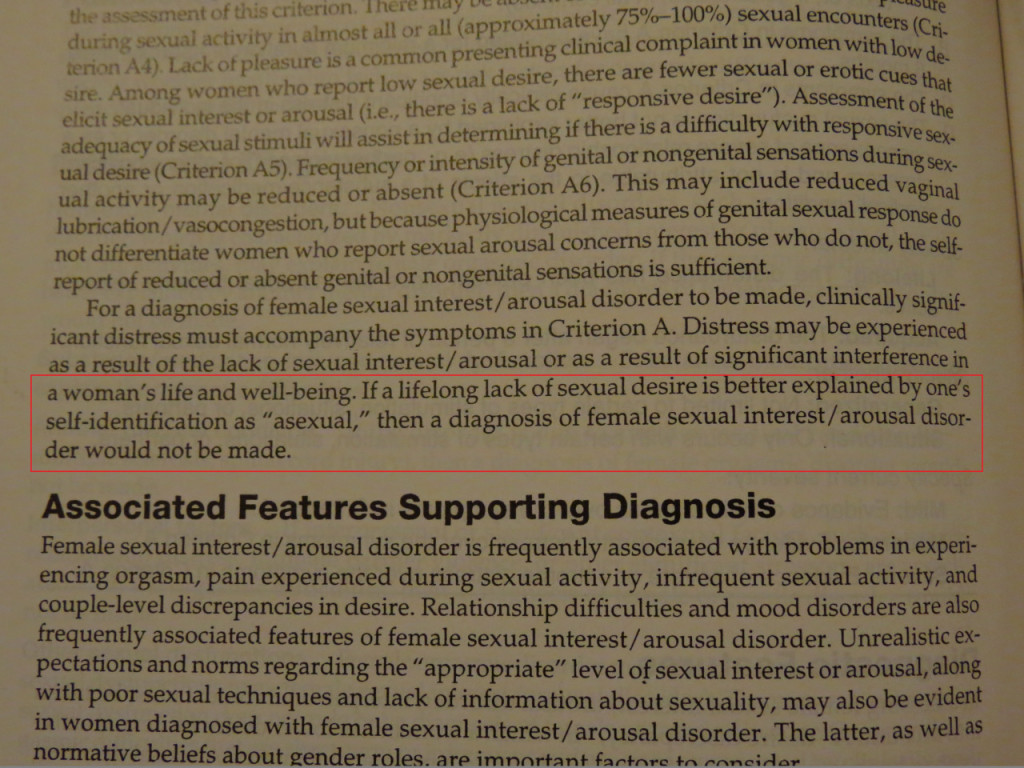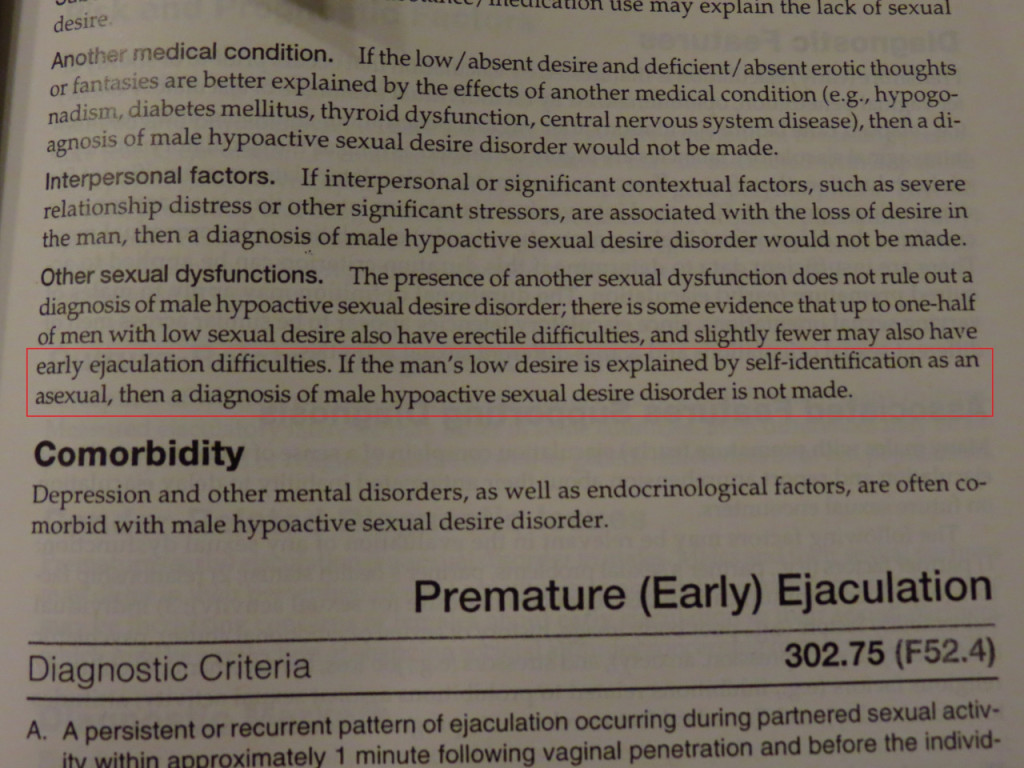Asexuality is OFFICIALLY not a disorder, according to the APA.
The images above are from the DSM-5, which is the latest edition of the American Psychiatric Association’s Diagnostic and Statistical Manual of Mental Disorders. The DSM-5 is a really important book. It is used by doctors and mental health care providers around the world to diagnose mental disorders.
The DSM-5 explicitly and clearly recognizes asexuality, and says that if a person is asexual, that they should not be diagnosed with Female Sexual Interest/Arousal Disorder or Male Hypoactive Sexual Desire Disorder.
This book reaffirms that you are valid, your feelings are real, and that you do not have a disorder for feeling that way.
Anyone who claims otherwise is wrong.
They do not know what they are talking about. You can point them at this book as proof that they are wrong.
Full Reference:
On page 434, in the section on Female Sexual Interest/Arousal Disorder (302.72), at the end of the “Diagnostic Features”, it reads:
If a lifelong lack of sexual desire is better explained by one’s self-identification as “asexual”, then a diagnosis of female sexual interest/arousal disorder would not be made.
On page 443, in the section on Male Hypoactive Sexual Desire Disorder (302.71), at the end of the “Differential Diagnosis”, it reads:
If the man’s low desire is explained by self-identification as an asexual, then a diagnosis of male hypoactive sexual desire disorder is not made.
Certainly, this is a vast improvement over what was in the DSM-IV. Not only was there no asexuality exclusion there, but “interpersonal difficulty” was one of the diagnostic criteria for HSDD. That meant that even if you were fine with being asexual, you could still be diagnosed with HSDD if someone else had an issue with it. Additionally, the description of “Lifelong Generalized HSDD” was very similar to how people describe asexuality.
But this is not enough…
There are problems with what’s in the DSM-5.
- “Scare quotes”: One of the most noticeable issues is that in the section for FSIAD, the word asexual is in quotation marks. This has the unintended side effect of delegitimizing asexuality in the minds of the reader. They might see asexuality as a real thing, but have more doubts about “asexuality”.
- Self-identification: As written, these exclusions require that the patient say “I’m asexual” for them to apply. That’s fine for those of us who know who we are, but what about those who don’t? You can’t self-identity as asexual if you’ve never even heard of asexuality. And there are hundreds of thousands, if not millions, of people out there who are in that situation. I’ve personally heard stories of people who have gone through “treatment” for HSDD. It didn’t work and made them miserable. Only afterwards did they discover that they were ace. Self-identification only works when there is widespread awareness. Psychiatrists need to be proactive in this regard. Certainly, a psychiatrist should never “diagnose” someone as asexual, but they need to be providing the tools and information for their patient to make that determination on their own.
- Asexuality is not mentioned in the Desk Reference version of the DSM: The DSM is a thousand page, 3 lb. monster of a book. Because of this, there’s an abridged variant, that only contains the diagnostic criteria. Unfortunately, there’s no mention of asexuality in the diagnostic criteria for either disorder. The asexuality exclusion is located in a different section of the text. That means that if someone just looks at the diagnostic criteria in the Desk Reference, they’re not going to see it.
- Clinically Significant Distress: Part of the diagnostic criteria for these disorders is that there must be “clinically significant distress”. But… Repeatedly being told that you’re broken can cause “clinically significant distress”. Wondering why you’re so different from everyone else can cause “clinically significant distress”. Being pushed to fix something when there’s nothing wrong can cause “clinically significant distress”. None of those are signs that you have a disorder, those are signs that the world around you has a disorder.
One more thing…
I would like to make it clear that I am not saying “We are valid because we’re in this book.” We are in this book because we are valid.



Hmm, I am flabbergasted by the realization that in all likelihood I could be asexual.
This posting, Parts 1, 2, and 3 Could have not been more accurate about me and my life experiences. It is as if, at the top of the page there was a sentence stating, The following information is an outsiders rendition of the life and times of P.R.
I can not count the number of times throughout my life that I had found myself in hot water without having a single clue why? As I look back, I realize what a fool I had made myself out to be, simply by not knowing, or realizing, that others believed there was a sexual element involved in either the things I said, My actions, Or the situations I had either created, Become involved in, or been a part of. Looking back, I am reminded of the old saying,… I wish I knew then what I know now.
I suppose I can consider myself lucky. This is the third time in my life the Internet has helped me to uncover a “Mind Blowing”, Surreal, Life changing event.
Such an event that may never have been realized, Nor major problem solved, without the aid and assistance of a sharp mind. A never ending quest for knowledge, and perhaps, the invention of the greatest tool known to mankind,… The Internet.
thank you for posting that.
I’ve now read quite a bit about asexuality and on different ocassions the discussion turned to the point of “there is no scientific research / it’s just a made-up label / …”
and knowing this topic is discussed in the “mental-illness-bible” and considered valid and not an illness seems great.
Pingback: Being Asexual in a Compulsorily Sexual World
Thanks